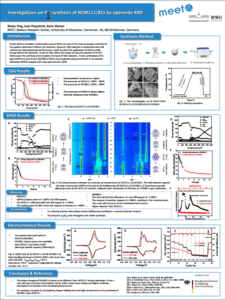Summary:
Ni-containing lithium transition metal oxides such as NCMs (LiNixCoyMn1-x-yO2, 0 ≤ x, y ≤1.0) are one of the most promising candidates for the positive electrode in the next-generation lithium-ion batteries (LIBs) due to their high specific capacity (over 220 mAhg-1) [1-5]. However, Ni/Li disorder in octahedral sites still restricts the electrochemical performance, which burdens the application of NCMs in high energy lithium-ion batteries. [6-8]. In order to tackle this problem, various strategies have been executed to lower the cation disordering, such as core–shell structures [9-10], concentration gradient structures [11-12], cationic substitution [13-14]. To get an idea about the unique structural evolution of Ni-rich NCMs upon the synthesis and to explore the issue of Ni/Li disorder, which increases with an increasing Ni content, an in-situ synthesises of Ni-poor (NCM111) and Ni-rich (NCM811) NCMs was employed using synchrotron X-ray powder diffraction (SXPD) coupled with mass spectrometry (MS).
Compared to NCM111, the synthesis of NCM811 contains a rock slat type TM-O intermediate which slows down the reaction kinetics (leads to higher activation energies), accounting for the necessity of high temperature and a longer calcination time. Additionally, in order to lower down the degree of disorder, a strong oxidizing atmosphere is neccessary for rapid oxidization of Ni(II) to Ni(III) [15]. Besides, an Li2CO3 impurity, which might arise from a reaction of LiOH·H2O with CO2 in air, appears throughout the whole synthesis, which could also be a problem worth solving for a successful Li-intercalation process. These would be meaningful to the design of high-performance Ni-rich layered oxides through synthetic control.
We are happy to forward your request / feedback.

